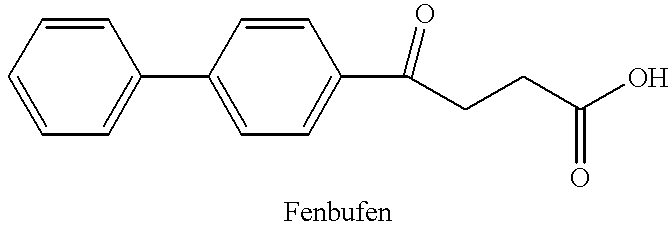Inhibition of matrix metalloproteases by substituted biaryl oxobutyric acids
a technology of biaryl oxobutyric acid and matrix metalloprotease, which is applied in the field of enzyme inhibitors, can solve the problems of obviating or delaying surgical intervention, no marketed pharmaceutical agent is able to prevent or slow cartilage loss, and total loss of joint function
- Summary
- Abstract
- Description
- Claims
- Application Information
AI Technical Summary
Benefits of technology
Problems solved by technology
Method used
Image
Examples
example 2
[0192] Example 2 - Preparation of Compound II 51
[0193] Step 1. The benzyl ester was prepared in a manner analogous to the one described for the corresponding 2-trimethylsilyl ester intermediate (example 1, steps 1-7). In this case, benzyl alcohol was used instead of 2-trimethylsilylethanol in step 1. 52
[0194] Step 2. A solution of the intermediate from step 1 (0.020 g, 0.045 mmol) and diisopropylethylamine (0.025 mL, 0.144 mmol) in CH.sub.2Cl.sub.2 (1.5 mL) was treated with benzyl chloromethylether (0.016 mL, 0.099 mmol) and stirred at room temperature for 6 h. Purification of the concentrated reaction mixture, by flash column chromatography (5-20% EtOAc-hexanes) provided the desired ether (0.022 g, 86%). TLC: R.sub.f 0.25 (silica, 20% EtOAc-hexanes). 53
[0195] Step 3. A solution of the intermediate benzyl ester from step 2 (0.020 g, 0.035 mmol) in THF (0.4 mL) and ethanol (0.4 mL) was treated with NaOH solution (0.14 mL, 0.5 g / 10 mL water). After stirring for 45 min. At room tempera...
example 3
[0196] Example 3 - Preparation of Compound III 54
[0197] Step 1. A solution of the alcohol from example 2, step 1 (0.100 g, 0.223 mmol) and diisopropylethylamine (0.05 mL, 0.287 mmol) in CH.sub.2Cl.sub.2 (3.0 mL) was treated with p-toluenesulfonyl chloride (0.048 g, 0.249 mmol) and a crystal of DMAP. The mixture was stirred at room temperature for 16 hrs., concentrated under reduced pressure and purified by MPLC (0-20% EtOAc-hexanes) to give the desired tosylate (0.118 g, 88%). TLC: R.sub.f0.23 (silica, 0-20% EtOAc-hexanes). 55
[0198] Step 2. A solution of the tosylate from step 1 (0.039 g, 0.066 mmol) and 18-crown-6 (0.044 g, 0.166 mmol) in DMF (0.7 mL) was treated with sodium pyrrolidine dithiocarbamate (0.035 g, 0.165 mmol) and stirred at room temperature for 16 h. The reaction mixture was diluted with EtOAc and water. After separating the phases, the organic layer was washed with satd. aq. NaCl, dried over MgSO.sub.4, filtered and concentrated. Purification by MPLC (3-15% EtOAc-he...
example 18
[0201] Example 18 - Preparation of Compound XVIII 74
[0202] Step 1. A solution of pthlalazinone (1.00 g, 6.84 mmol), triphenylphosphine (1.79 g, 6.84 mmol) in THF (25 mL) was cooled to 0 .degree. C. and treated with 2- bromo ethanol (0.480 mL, 6.84 mmol) and diethyl azocarboxylate (1.07 mL, 6.84 mmol). After stirring 1 h at 0.degree. C., the solution was warmed to room temperature and strirred for an additional 12 h. The resulting mixture was concentrated and purified by flash column chromatography (35% ethyl acetate-hexanes) to afford 1.40 g (81%) of bromo ethyl phthalazinone as a white solid. TLC: R.sub.f 0.65 (40% ethyl acetate-hexane). 75
[0203] Step 2. A solution of sodium hydride (0.040 g, 1.54 mmol) in THF (5 mL) was cooled to 0.degree. C. and carefully treated with diallyl malonate (0.260 g, 1.41 mmol). After warming to room temperature and stirring for 20 min., bromo ethyl phthalazinone from step 1 (0.325 g, 1.28 mmol) was added in one portion and the mixture was heated to re...
PUM
| Property | Measurement | Unit |
|---|---|---|
| temperature | aaaaa | aaaaa |
| temperature | aaaaa | aaaaa |
| temperature | aaaaa | aaaaa |
Abstract
Description
Claims
Application Information
 Login to View More
Login to View More - R&D
- Intellectual Property
- Life Sciences
- Materials
- Tech Scout
- Unparalleled Data Quality
- Higher Quality Content
- 60% Fewer Hallucinations
Browse by: Latest US Patents, China's latest patents, Technical Efficacy Thesaurus, Application Domain, Technology Topic, Popular Technical Reports.
© 2025 PatSnap. All rights reserved.Legal|Privacy policy|Modern Slavery Act Transparency Statement|Sitemap|About US| Contact US: help@patsnap.com



